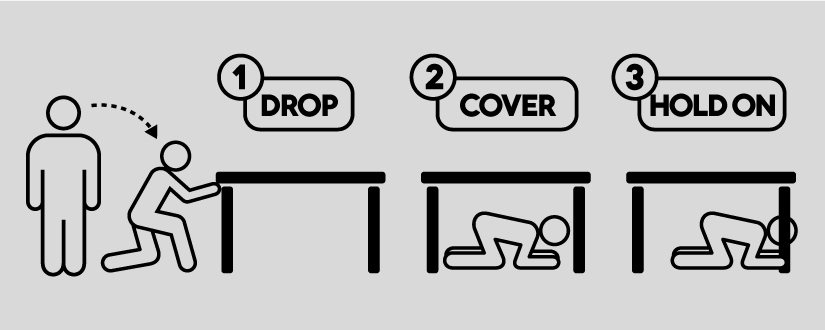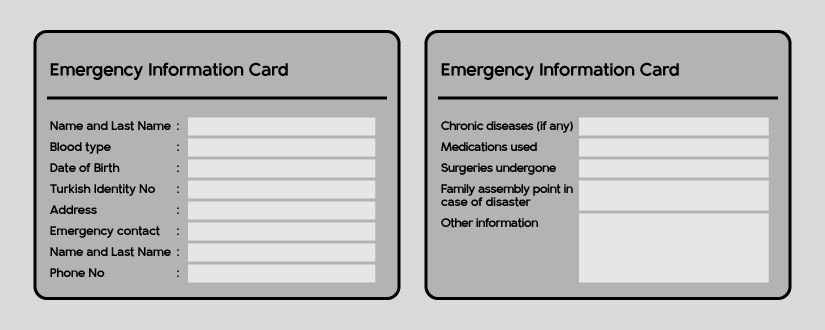Protection of Persons with Disabilities During Emergencies
Protection of Persons with Disabilities During Emergencies
All people with our without disabilities should be ready for emergencies (earthquake, fire, etc.) and we should be aware of what to do in such case to protect ourselves. For people with disabilities, it is also vital to know how people in their surroundings can help them in addition to knowing what to do themselves.
Individuals with Visual Disabilities:
You should make sure that the furniture in the areas you are usually located at has been fixed before earthquakes. If you are located in a particular area, there should be objects that have a lower chance of being crushed down such as a sofa, bed, washing machine, dish washer, etc. where you can lie down in fetal position and can apply "Drop, Cover, Hold on" method. You should definitely perform drills in this area at regular intervals.
Do not panic during an earthquake. Stay away from windows. If you are alone, you should take position according to your disability status, and protect your body. Apply "Drop, Cover, Hold on" method in a manner to protect your head. If you are in an unfamiliar environment during an earthquake and there is nobody that accompanies you, or if you in an environment with glazed tile surfaces such as kitchen or bathroom, move to another room and ask help from people around you. If you are on a balcony, go indoors and if you are on stairs, get support from the walls and move to the closest floor.
Individuals with hearing disabilities:
You should make sure that the furniture in the areas you are usually located at has been fixed before earthquakes. If you are located in a particular area, there should be objects that have a lower chance of being crushed down such as a sofa, bed, washing machine, dish washer, etc. where you can lie down in fetal position and can apply "Drop, Cover, Hold on" method. You should definitely perform drills in this area at regular intervals.
Do not panic during an earthquake. Those who can protect themselves should minimize target once the shaking starts, and there should be objects that have a lower chance of being crushed down such as a sofa, bed, washing machine, dish washer, etc. where you can lie down in fetal position and can apply "Drop, Cover, Hold on" method. You should definitely perform drills in this area at regular intervals.
If you are in an environment with glazed tile surfaces such as kitchen or bathroom, move to another room. Stay away from windows. Be visually alert for hazards that may come from around and outside. Make sure that there are no problematic objects that can fall on you and no non-structural elements that can crush down. If you are on a balcony, go indoors and if you are on stairs, get support from the walls and move to the closest floor.
If you can vacate the building on your own, make sure that there are not any elements that are likely to obstruct exits. When necessary, use the alternative evacuation exits designated in advance.
Take your bag that contains your documents in case of emergency with you.
If you cannot vacate the building on your own (either on a wheelchair or without a wheelchair), support and inform the person to provide assistance for your easy transportation.

Individuals with physical disabilities:
Do not panic during an earthquake. If you are alone, you should take position according to your disability status, and protect your body.
The actions to be taken may be summarized as follows:
- If you are on a wheelchair, do not throw yourself out of your wheelchair.
- Activate the wheel brake and hold on. Try to protect your head.
- If you are staying, stay where you are and protect your head if possible.
- If you are standing, sit down and support your body to avoid falling down and protect your head.
- As you go to bed at night, keep your special devices such as prosthesis near you and in an easily accessible place.
Those who can protect themselves should minimize target once the shaking starts, and apply "Drop, Cover, Hold on" method.
If you can vacate the building on your own, make sure that there are not any elements that are likely to obstruct exits. When necessary, use the alternative evacuation exits designated in advance. Take your bag that contains your documents in case of emergency with you. If you cannot vacate the building on your own (either on a wheelchair or without a wheelchair), support and inform the person to provide assistance for your easy transportation.

Support Network
List the people who can assist you in case of emergency (family / friends and employees where the individual resides, receives education or works).
Emergency documents
- Photocopies of identity card, documents related to social security and health and similar documents
- Photocopies of all essential documents including disability status of individuals with disabilities
- Photocopy of the disabled person identity card
- A document containing the contact information of the people in the support network and the physician of the person with disability
- If the individual with disability uses a device or equipment, a written document explaining how these devices and equipment are used and the contact information from where these equipment may be supplied
Disaster and emergency bag
- Emergency documents
- A written instruction for those to assist the person with disability
- Medications used
- Tools and equipment used, spare batteries for hearing aid
- Hand torch, whistle etc.
- Hygienic materials, etc.
Emergency Information Card

İstanbul Bilgi University
Prepared by Occupational Health and Safety Experts.